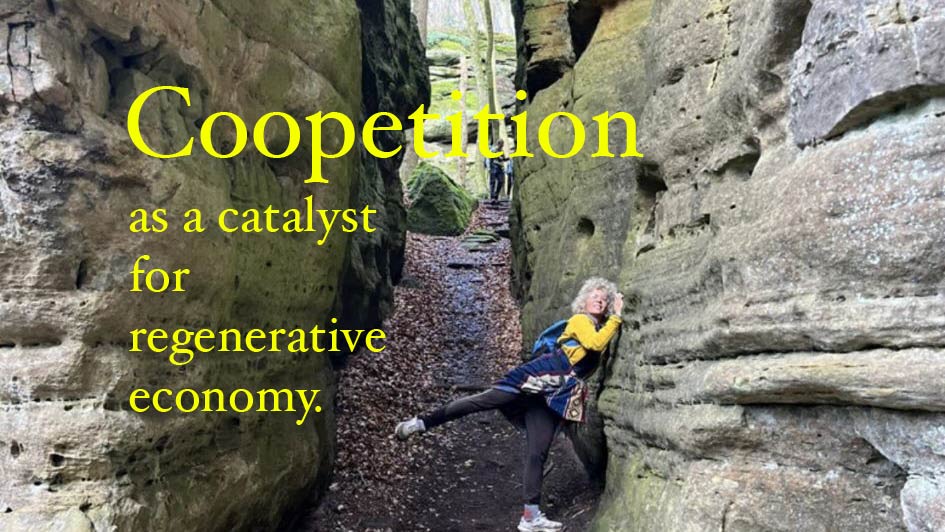
Business as usual, even when “greener,” falls short of the regenerative turn: an approach that not only sustains but restores, renews, and reimagines our social and ecological foundations. The scale and urgency of regenerative change challenge the foundations of traditional competitive logic. In this context, coopetition, the blending of cooperation and competition between business rivals, stands out as a potent, under explored catalyst.
"Coopetition" is the simultaneous pursuit of cooperation and competition among business rivals – is a practical strategy for value creation, resource efficiency, and innovation. Academic literature identifies coopetition as an enabler in dynamic industries where companies face complex challenges that no single actor can solve alone.
A regenerative economy goes beyond traditional sustainability. Instead of simply minimizing harm, it seeks to restore, renew, and revitalize its own sources of energy and materials, supporting both environmental and social renewal. Regenerative business models employ principles like circularity, adaptability, collaboration, and value reinvestment, ensuring long-term ecosystem and societal health.
Drawing from strategic management, innovation studies, and regenerative economics, we delineate five key ways that coopetition underpins and accelerates the regenerative economy. Here they come:
1. Collective Innovation for Regeneration
Regenerative economies depend on breakthrough innovations – new materials, business models, and technologies—to restore ecosystems and society. Coopetition encourages resource sharing, joint R&D, and mutual learning, making large-scale innovation both feasible and less risky for individual firms. For example, in “circular economy” directly competing enterprises can collaborate to create shared standards, recycling infrastructure, and systemic change –results that cannot be achieved in isolation.
2. Value Creation Beyond the Enterprise
Unlike competition that maximizes private gains, coopetition in a regenerative context enables collective value generation across supply chains and communities. Enterprises jointly address resource scarcity, pollution, and climate change – key pillars of regenerative economics. The Competitive Circular Business Model (CCBM) synthesizes coopetition and circular economy principles, enabling enterprises to innovate in product design, resource recovery, and waste minimization, all essential toregeneration.
3. Systemic Collaboration and Governance
Regeneration requires new forms of governance and relationship-building – not just within enterprises but across industries, governments, and civil society. Academic research shows that coopetition fosters collaborative ecosystems, builds trust, and enables distributed leadership required for regenerative transitions. International organizations and multi-stakeholder initiatives often use coopetition frameworks to align industry with broader societal goals, such as the UN Sustainable Development Goals and climate agreements.
4. Accelerating Sustainable Performance
By pooling resources, knowledge, and expertise, enterprises can undertake ambitious projects that would be prohibitively expensive or risky alone. Joint innovation initiatives produce breakthroughs in sustainable technologies, materials, and processes faster and more efficiently. Coopetition enables enterprises to coordinate logistics or sustainable sourcing programs that reduce emissions collectively. For example, logistics companies in supply chains can collaborate on joint transportation routes to minimize empty miles, thereby reducing carbon footprints and increasing efficiency. Studies confirm that coopetition improves not only economic performance but also social and environmental outcomes – critical for regeneration. Enterprises actively engaged in coopetition for sustainability outperform those operating alone in metrics such as innovation, emissions reduction, and social impact.
5. Managing Risks and Tensions
Coopetition enables risk-sharing and learning, but also necessitates sophisticated management of tensions around knowledge protection, resource allocation, and strategic goals.
Coopetition as a foundation of regenerative futures.
Coopetition emerges in academic and practical discourse as a fundamental logic for twenty-first century regeneration. It moves enterprises beyond the limitations of solitary competition or simplistic collaboration, amplifying innovation and facilitating systemic, stakeholder-centric impact. Supported by academic theory and empirical evidence, coopetition is proving vital for realizing the regenerative economy’s boldest ambitions: to restore, renew, and sustain thriving economies within planetary boundaries. As organizations increasingly embrace this strategy, the possibilities for a regenerative future become more attainable, more resilient, and more inclusive.
With gratitude to Iris Lubitch for contributing this insightful exploration of coopetition as a driver of regenerative economies. Your voice adds depth and clarity to one of the most urgent conversations of our time:
Iris Lubitch (LL.B, LL.M, MBA) - Regenerative Investor Relations Strategist, Lecturer in Impact Entrepreneurship, Lawyer, Activist for a Thriving Planet